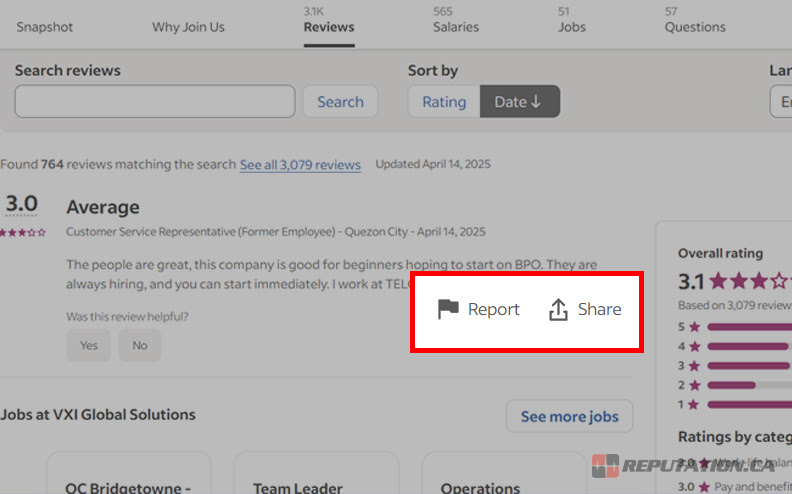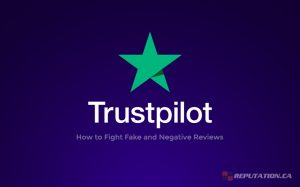Job seekers will often check employer reviews before deciding whether to apply and websites like Indeed also play a big part in how businesses bring in new people. You can almost feel the hesitation in applicants’ decisions. It’s a numbers game. Even just one negative comment can throw off your whole hiring process.
Indeed has already set some guidelines about removing reviews, and in most cases, employers still can’t just delete feedback as they please. When unfair comments show up, it can seem especially frustrating to watch them hurt your recruitment – but there are also ways to report the problems, and you can use Indeed’s system to your benefit.
Here, you’ll find some helpful steps for how you can work with tough reviews – like when and how to flag something that goes too far. You’ll also find some tips on what to do next if you need to take things further. Don’t panic if things don’t vanish overnight. Time is your friend here. First, you’ll just want to get an idea of what counts as a removable violation and which steps take priority.
Some people think that you can just flag any rough feedback, and it’ll disappear. That’s wishful thinking, sadly.
Let’s simply get started on how you can make the review removal process actually work for you.
The Facts About Review Removal
Some employers think that they can just delete the negative reviews from their Indeed profile in a few easy steps. That’s not how it works at all.
Indeed doesn’t let the businesses remove the reviews by themselves. Only the person who wrote the review can take it down, or you need to submit a report so Indeed’s moderation team can check for a policy violation. If you come across a harsh review, it’s tempting to try to have it removed – we’ve all been there, that sinking feeling when criticism pops up. But unless the review breaks any of Indeed’s rules, it’s still going to stay right where it is.

People assume that any tough or unfair comment can just be flagged out of existence. That’s not the case. Indeed’s guidelines specifically look for types of policy violations. If someone leaves a comment labeling a coworker “unprofessional,” you might find it upsetting. But that alone isn’t enough to get the review taken down. The system’s built to stay neutral, with no exceptions. If the same review includes personal attacks or gives away private information, then you have a stronger reason to report it. The line between something that feels unfair and something that breaks the rules is much clearer than it seems.
Whenever you flag a review, Indeed’s team also closely checks it against their published standards. They don’t lean toward helping either the employers or the employees. Their goal is to follow the rules. Even if you find a review misleading or incomplete, that doesn’t mean it qualifies for removal. Recent studies have shown that less than one in five flagged reviews come down. Numbers don’t lie – tough odds to beat. You should try to check Indeed’s guidelines before you send in a report. You can save your time by learning about what counts as a violation.
You might hear that negative reviews can eventually disappear by pushing hard enough. That’s not true at all. The effort alone won’t get around the policy. Put your energy into answering the real feedback where everyone can see it – this fits with Indeed’s guidelines. But it also helps you show future job candidates that you pay attention.
What should you do going forward? If a review isn’t breaking any rules and is negative, your smartest move is usually to reply politely. A measured response goes further than you think. If you come across something that crosses the line, get together your information and just go ahead with a report. The next part helps you find the policy violations so you can spend less time worrying and more time managing the reviews that matter.
When A Review Violates The Rules
When a review on Indeed crosses boundaries, you have some options for what you can do next. The platform also lists out some clear rules for what’s not allowed. A quick example is that reviews that use hate speech will also get taken down. The same applies to reviews that share someone’s private information, such as their home address. The reviews that make unsupported claims about illegal activity are removed as well. Even if a review feels very unfair to you, it still needs to break a policy before it’ll be deleted. Let’s say that someone writes, “The manager is rude.” That could be tough for you to read. It hits harder than you’d expect. It doesn’t break any of the rules. If someone claims the manager stole money without any proof, that can become a different situation.
People assume that any harsh review is “defamatory” and should be removed by the platform. As another example, a client of mine once spent a few weeks going back and forth with Indeed over a comment calling their business “disorganized.” They strongly insisted that it was untrue about their company. Opinions can sting you. They’re protected speech. Since that review was mostly just an opinion, it stayed up on the site.
You’ll see some reviews with questionable language that are still up online for everyone to see. That’s because it’s not always easy for you to tell where criticism stops and a rule violation begins. Vague statements might stay on the site. Mentioning an employee’s name along with facts about their medical condition would break privacy rules and get removed faster.

Before you report any review, take some time to get together some proof for your case. You should grab the screenshots of the review. You should also jot down the important dates. Save the exact phrases you want to flag. You might still need this information if things move past Indeed to other places. Legal action can be slow and doesn’t always give you the exact result you want in these situations.
If a review makes a big accusation – like saying your business committed fraud – talk to a lawyer. Even though Indeed removes these claims when reported, sometimes their response isn’t immediate. You can check in with a legal professional to give you a chance to weigh your next steps.
Try not to respond out of your frustration with the review. When you flag every single bad review, it can make some things harder for you in the long run. You should focus your work on the ones that do break the rules. If you’re on the fence about something being out of line, you should get together your evidence anyway for later. That way, you’re completely ready for whatever situation comes up next.
The Review Reporting Process
First, you’ll want to find the comment that crosses the line to report a review on Indeed. You can also see a “Report” button close to the review itself. Go ahead and click it. A form will then actually pop up and let you pick the reason why you’re reporting it – they’re pretty quick about it, too. Choose as specifically as you can since vague claims don’t get much traction. They need some clear breadcrumbs to follow.

Next, you should share some context with them. Skip the emotional wording and just give the facts to them. If the review has incorrect information about how your company operates, point out the inaccurate facts and describe how this actually works. One HR manager mentioned that when they rewrote a report and took out the frustrated wording, the issue got solved faster. Stick to the cold, hard details here. Include what happened – not how it felt to you.
Once you send in your report then you’ll only have to wait a bit for a response. Indeed’s team responds in two to five business days, though it might sometimes take longer around the holidays or during busy times. If they reject your report, try not to worry about it too much. Reports are turned down because the evidence isn’t clear enough or there’s not enough detail provided.
Don’t make the mistake of thinking that the moderators can guess what you mean if you don’t give them the basics. Always try to add some screenshots or internal records when you can do so. If you don’t do this, even a valid report might not go anywhere for you. Paper trails always speak louder than your explanations.
Remember that not every negative review can be removed from the site for you. Indeed focuses on real experiences, so you’ll only see a review taken down if it breaks their rules. If your first report doesn’t get results, you still have some more ways to take action. That’s something we’ll cover in the next section.
Evidence And Patience During Escalation
You should use Indeed’s help center if you want to reach out about a review – most of the time, it’s the quickest way for you to get a reply. If that doesn’t work, you can still go ahead and try to reach them by email or through their social media accounts. Make sure that you stay calm when you talk with them. You should just take a deep breath before hitting send. Easier said than done, I know. You should simply skip any accusations or angry language. Just follow the facts and state them as best you can. If the review breaks Indeed’s rules – like if it includes some personal attacks or things that aren’t true – call them out with some exact facts.

After you reach out, you should also give their team at least 72 hours to get back to you – this gives them enough time to check your case. When you press for a fast answer, it can hurt your opportunities, so you should hold off before sending a follow-up. Patience is part of the process. You can say that you’re waiting for a reply to an important email. If you push too early, it can work against you in the process.
In one situation, a small business owner only had a review removed after showing screenshots that proved the reviewer never worked there. Their first request didn’t work because they didn’t send in enough proof. That’s why you need to have some documentation ready to improve your case. You should save every message you send to Indeed. You should also note down the dates and record any case numbers you receive.
If a review accuses you of something – like discrimination or breaking the law – you should talk to a lawyer before you do anything else. Legal matters can get tough very fast, and only a lawyer can help here. Even if you feel sure that the review isn’t true, a legal opinion always helps you to figure out your next move.
Even when you do everything right, Indeed may sometimes still refuse to remove the review. If this happens, you should think about your next steps. Before you hire any outside help, you can start to work on how you shared your side of the story. Sometimes, even a change in how you explain things can turn things around for you. Why not try this?
Professional Reputation Services Pros And Cons
When you have had some tough negative reviews on Indeed and handling them on your own just isn’t working, you might start thinking about getting help from a reputation management company. These businesses say that they know how to work within the platform guidelines and also help you get those unwanted reviews taken down. Still – you’ll want to look at the price compared to what you might actually get out of it. That’s real money on the line, with no guarantees. Costs can sneak up on you. These services can still cost anywhere from a few hundred dollars to a few thousand, depending on how tough your situation is.
A company may promise you that you only need to pay if they get the results. But there’s still some fine print. Things don’t work that way since places like Indeed don’t make their review rules public. That makes it tough for anyone to promise you success. One manager from a reputation company said, “We can’t make the final call – we just try every possible path and hope persistence pays off.” You’re paying for the effort, not the results. Look for this frankness when you’re talking to possible services for the first time.
If you want to check out some professional help, get yourself ready with some important questions. Ask about what they actually do and request examples of similar cases. Question how they can work with the pushback from businesses like Indeed or how they can get through gray legal areas. An honest agency will tell you about their steps without making a big deal about it. If anyone hints at a “secret trick” or pushes you to sign faster, take that as a warning sign.

If you take care of things on your own, it might mean fewer out-of-pocket costs for you. But it does actually take a fair amount of your time and effort. You’ll need to dig into Indeed’s review guidelines and put together some appeals that follow their standards. Some people feel OK taking this on themselves. Others find that when they spend hours writing emails and waiting for replies, it makes them wish they’d hired someone after all. Hours end up adding up faster than you would think.
Remember that not all reputation agencies play fair. A small number use risky or shady plans that could end up putting your business into even more problems or taking a chance with your account status. Just for example, one bakery owner shared how a company decided to flood their profile with some fake reviews, only for Indeed to temporarily suspend their page. Shortcuts often come with hidden price tags. Always make sure to check who you’re working with. Look for real reviews and just check the references before you make a choice.
If you can’t get a review taken down, it just helps to know how you can build up your reputation in a steady way for your business. Remind your happy customers to leave real feedback, and be sure to reply calmly to any negative comments you can’t remove. As more positive reviews come in over time, the older criticism matters less and less – this takes some patience from you. But it helps your business’s page look better as the months go by.
Positive Responses And Reputation Building
If you see a negative review pop up, your first reaction could be to just try and take it down. But if removing it still isn’t an option, a caring reply can also help effectively. Speed here makes all of the difference. You should find the concern and just try to avoid being defensive. You can use some easy phrases like “We like your feedback” to show that you’re paying attention. Your response should be short – you should shoot for just a couple of sentences with no tough language. You should try to reply within a day or two, so people know you’re paying attention. It might feel a little bit strange for you. But when you stay calm and respond faster, you can reassure future job seekers more than leaving things unaddressed.
And as you manage the tough feedback, try to remember some ways to point out the positive, too. You should also ask your team or your clients to share their thoughts after a project or during the yearly check-ins. A quick reminder by email or in the meetings can end up helping to get the ball rolling for you. The more real, upbeat reviews you get together over time, the less space a random negative comment will take up in the picture. It’s almost like you’re slowly tipping the balance in your favor. One company saw that a tough review faded away after they managed to double their positive feedback over six months. Consistency here still stacks up over time.

Try to put yourself in the shoes of a careful job seeker who’s reading your replies to reviews. Would your answers help them feel better about picking you for the job? They’re watching for how you handle the rough patches. When you’re open, it goes a long way, even if you can’t fix every issue in public. People can see when you’re open with them. If someone brings up a real problem, you should mention the steps you’ve taken to fix it in a general way. When you say something like, “We’ve updated our onboarding process to make our communication clearer,” it shows that you’re making progress on problems. But you don’t need to share every single detail with everyone.
Actually making this a standard habit can take some practice for everyone. But with it established in your schedule, it’ll improve your reputation. You should add a reminder to check for the new reviews every week on your calendar. You can give your team some ideas on how they can write replies that sound like your company’s voice. And always remember that every reply is a chance for you to show what matters to you.
One great response won’t make a bad review vanish completely away from sight. But it helps to move things in a better direction for your business.
Monitor and Manage Your Reputation
When you manage the negative reviews, it just takes some time and patience once you’re aware of how the process works. When you set your basic expectations right from the start, you can also see better results. Not every review can be removed, and sometimes, your best move is to build enough positive content to outweigh the negative ones – it’s a slow burn. It might take longer than you’d hope. But it does add up over time. You have likely seen that some strategies are more helpful than others.
When you learn how the removal works, gather good evidence, and practice some patience if you need to escalate a case, you can give yourself a better chance for fair treatment. At the same time, remember how much it helps to answer the reviews professionally and build a positive reputation for the long run.

Want to take charge of your own reputation online? Trust our team here at Reputation.ca – we manage reviews, social media, public relations, and crisis response for you. If you have to deal with cancel culture or want to go for a stronger presence – we’re here and can help you anytime.
Get in touch with us for a free personalized consultation!











